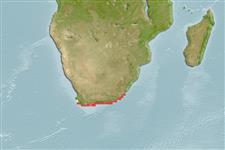Gastropoda |
Lepetellida |
Haliotidae
Environment: milieu / climate zone / depth range / distribution range
Ecology
Benthic; depth range 0 - 10 m (Ref. 81186). Subtropical, preferred 25°C (Ref. 107945); 32°S - 35°S, 18°E - 30°E (Ref. 81186)
Southeast Atlantic: South Africa.
Length at first maturity / Size / Weight / Age
Maturity: Lm ?, range 2 - 2.5 cm Max length : 25.0 cm ShL male/unsexed; (Ref. 356)
This species is one of 5 Haliotis species endemic to South Africa. It is the largest and most abundant of the abalone species in this country. Found on rocky reefs between the intertidal and subtidal zones up to a depth of 10 m (Ref. 81186).
Broadcast spawner. No mating behavior. Spawning is initiated by the release of sperm cloud stimulating the females to release their eggs. Life cycle: Eggs hatch into trocophore larva moving actively in the water column and shortly after develops into veliger larvae, followed by substrate settlement and metamorphosis. Also Refs. 81186, 105512, 105513.
SAUP Database 2006 SAUP Database. www.seaaroundus.org. (Ref. 356)
IUCN Red List Status
(Ref. 130435: Version 2025-1)
CITES status (Ref. 108899)
Not Evaluated
Not Evaluated
Threat to humans
Human uses
Fisheries: commercial
FAO - Aquaculture: production; Fisheries: landings | FishSource | Sea Around Us
Tools
More information
PhysiologyOxygen consumption
Human RelatedStamps, coins, misc.
Internet sources
Estimates based on models
Preferred temperature
(Ref.
115969): 17 - 22.2, mean 19.9 (based on 38 cells).
Resilience
High, minimum population doubling time less than 15 months (K=0.14-0.81; tm=9).
Fishing Vulnerability
High vulnerability (56 of 100).
Climate Vulnerability
High vulnerability (64 of 100).
Nutrients : Calcium = 126 [75, 177] mg/100g; Iron = 4.79 [1.67, 7.92] mg/100g; Protein = 15.9 [14.8, 16.9] %; Omega3 = 0.331 [0.263, 0.400] g/100g; Selenium = 57.8 [48.5, 67.2] μg/100g; VitaminA = 0 μg/100g; Zinc = 1.97 [0.92, 3.02] mg/100g (wet weight); based on
nutrient studies.
